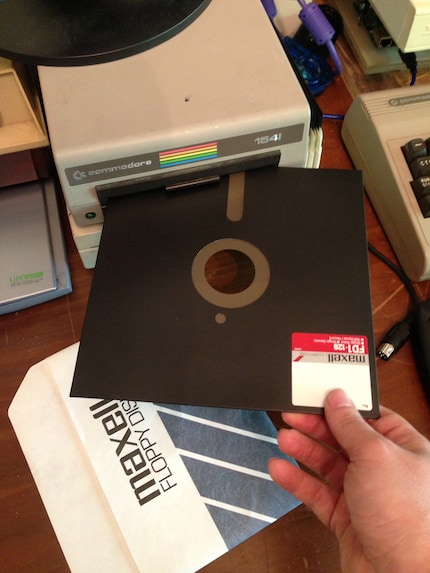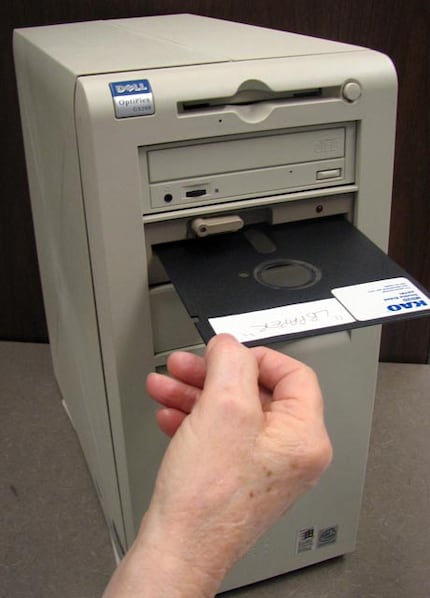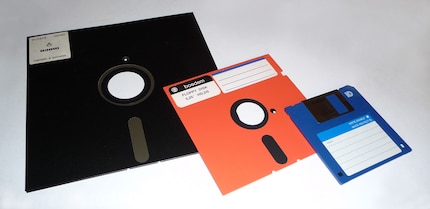
Background information
The microcomputer: success thanks to hobbyists and enthusiasts
by Kevin Hofer

2021 marks the 50th anniversary of the market launch of the floppy disk. The storage medium has long since disappeared from our computers. But the floppy has given rise to an entire industry.
When the floppy disk came onto the market in 1971, it was a revolution. For the first time, programs no longer have to be entered by hand, but can be loaded from the floppy disk. This is not only a revolution for computer users, but also for software developers: they can now sell their programs via a data carrier.
The invention of the floppy disk cannot be pinned down to one person. Even if Dr. NakaMats claims otherwise. The Japanese inventor claims over 3500 inventions. These include a self-defense wig and the floppy disk. However, he never built a prototype of the floppy, but only described how it worked. So he only invented it theoretically. He even holds a Japanese patent from 1952 for the invention.
Actually, IBM claims the invention of the floppy disk for itself. Nevertheless, the blue giant has some license agreements with Dr. NakaMats. So it is not clear whether IBM engineers were actually inspired by Dr. NakaMats.

Alan Shugart is often associated with the invention of the floppy disk. The latter heads development programs at IBM in 1967. He commissioned a team of engineers led by David L. Noble: they were to develop a new type of storage medium for mainframe computers. But not just any floppy disk: it should be simple and inexpensive and suitable for loading instructions and installing software.
The team initially wanted to use magnetic tape. But then they decide to use a disk coated with magnetic material. This is to be inserted through a slot in a drive and rotated on a spindle. In 1969, the floppy disk is born. These first floppies are 8 inches in size and bendable. From this pliability comes the name "floppy", meaning floppy.

The engineer David L. Noble mentioned above is no longer project manager at this time. Warren L. Dalziel has taken over this task in the meantime. So instead of one person, several people are involved in the invention and development of the floppy disk.
Since the floppy disks quickly become dirty, the developers pack them in a narrow but sturdy case with a dust-wiping element. From 1971 the first floppies are sold. They have a capacity of 3000 punch cards, or about 80 kilobytes (KB). However, these 8-inch floppies are unsuitable for the desktop computers that emerge in the second half of the 1970s. Nevertheless, the U.S. Air Force will continue to use them as data storage media until 2019.
This is where Alan Shugart comes in again. The latter is self-employed with Shugart Industries in 1976 and is commissioned by computer manufacturer Wang Laboratories to develop a floppy for their desktop computers. The 5.25-inch floppy disk was born. It has a capacity of up to 1.2 megabytes (MB). Initially, however, it could only hold 100 KB.

Why the floppy disk was 5.25 inches in size is not exactly known. According to a story, the engineers should have decided for the size, because the floppy disk has so not place in the trouser pockets. They didn't want the floppies to be carried in the trouser pockets for fear of breaking them. The other story goes like this: Two engineers from Wang Laboratories were sitting in the bar talking about the size of the floppy disk to be developed. They thought the cocktail napkin was a good size - it was 5.25 inches.
The 5.25-inch floppy doesn't catch on because of Wang's desktop computers, however. The Apple II can also read these floppy disks from 1977 onwards thanks to an optional drive. Thanks to the success of the Apple II, it becomes the standard. Most computers in the late 1970s and early 1980s used them.
This is also the time of the emerging PCs. This is not accidental. Because the floppy disk made it possible to transfer/install programs and data quickly and easily.
The PC becomes marketable thanks to the floppy disk - this also creates the software industry. If you are interested in that time of awakening, I can recommend the following articles.
The history of the 5.25 inch floppy disk does not last long. Sony introduced the 3.5-inch floppy disk as early as 1980. The term "floppy" no longer really fits, however, since it is much more stable. In 1988, it replaced the 5.25-inch floppy disk as the most important portable storage device. In the 1990s, the floppy disk with a storage capacity of 1.44 MB is the undisputed market leader for portable media.

Later, ZIP floppy disks from Iomega or Super Disk from Imation join the ranks. In the early noughties, the era of the floppy comes to an end. At first, rewritable CDs and DVDs took its place. With capacities of more than 1 gigabyte, they are far superior to the floppy. CDs and DVDs are later replaced by flash memory and high-speed Internet. Sony announces in 2010 that it will no longer produce floppies.
And Alan Shugart, the supposed IBM inventor of the floppy disk? He founded Seagate Technology in 1979. From then on, the company focused on hard disks. Shugart dies in 2006.
Another is Dr. NakaMats. The spiritual father of the floppy disk is now 93 and still inventing things. Thanks to a strict life plan, which he of course also invented, he wants to become 144.
From big data to big brother, Cyborgs to Sci-Fi. All aspects of technology and society fascinate me.
Interesting facts about products, behind-the-scenes looks at manufacturers and deep-dives on interesting people.
Show all